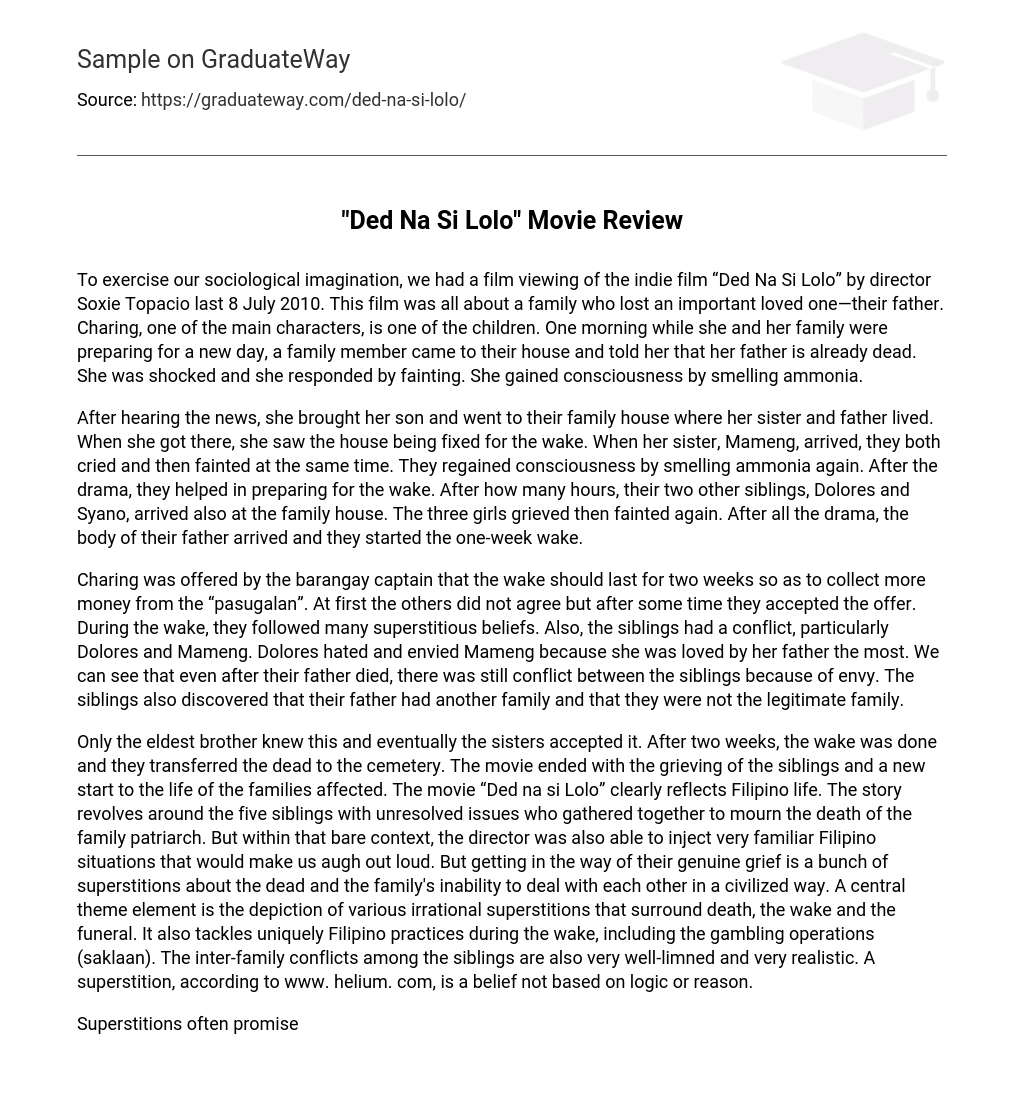To exercise our sociological imagination, we had a film viewing of the indie film “Ded Na Si Lolo” by director Soxie Topacio last 8 July 2010. This film was all about a family who lost an important loved one—their father. Charing, one of the main characters, is one of the children. One morning while she and her family were preparing for a new day, a family member came to their house and told her that her father is already dead. She was shocked and she responded by fainting. She gained consciousness by smelling ammonia.
After hearing the news, she brought her son and went to their family house where her sister and father lived. When she got there, she saw the house being fixed for the wake. When her sister, Mameng, arrived, they both cried and then fainted at the same time. They regained consciousness by smelling ammonia again. After the drama, they helped in preparing for the wake. After how many hours, their two other siblings, Dolores and Syano, arrived also at the family house. The three girls grieved then fainted again. After all the drama, the body of their father arrived and they started the one-week wake.
Charing was offered by the barangay captain that the wake should last for two weeks so as to collect more money from the “pasugalan”. At first the others did not agree but after some time they accepted the offer. During the wake, they followed many superstitious beliefs. Also, the siblings had a conflict, particularly Dolores and Mameng. Dolores hated and envied Mameng because she was loved by her father the most. We can see that even after their father died, there was still conflict between the siblings because of envy. The siblings also discovered that their father had another family and that they were not the legitimate family.
Only the eldest brother knew this and eventually the sisters accepted it. After two weeks, the wake was done and they transferred the dead to the cemetery. The movie ended with the grieving of the siblings and a new start to the life of the families affected. The movie “Ded na si Lolo” clearly reflects Filipino life. The story revolves around the five siblings with unresolved issues who gathered together to mourn the death of the family patriarch. But within that bare context, the director was also able to inject very familiar Filipino situations that would make us augh out loud. But getting in the way of their genuine grief is a bunch of superstitions about the dead and the family’s inability to deal with each other in a civilized way. A central theme element is the depiction of various irrational superstitions that surround death, the wake and the funeral. It also tackles uniquely Filipino practices during the wake, including the gambling operations (saklaan). The inter-family conflicts among the siblings are also very well-limned and very realistic. A superstition, according to www. helium. com, is a belief not based on logic or reason.
Superstitions often promise to protect someone from harm or affect either their bad or good luck. For example, sweeping the house during the wake and taking a bath at the house where the dead is laid. These superstitions have no logical basis, yet they are still followed just like in the movie. A belief in superstitions gives people an illusion of control in an uncertain world. Many superstitions originated at a time when little was known about how the physical world functions. People believe in superstitions because they want to believe in them. They will look for coincidental connections and label them as proof.
Some of the superstitions depicted in the movie during the wake are the following: no one is allowed to sweep and clean the premises of the wake, members of the immediate family are not allowed to accompany anyone to the door or gate when they are leaving and not allowed to take a bath inside the house where there is a wake, the feet of the dead should not face the front of the door, any red dress is not the appropriate color to wear in attending a wake, tears should not fall in the coffin, snipping the rosary that is wrapped around the hand of the dead to break the cycle of deaths in the family, no soup-based food during the wake, and many more. Also, the movie depicts the entire Filipino culture in a nutshell during a wake. The characters play their comically-over melodramatic roles. The siblings showed how they dealt with their father’s death: with over-the-top melodrama flair until one reaches (the ecstasy of) asphyxia. There are also issues of rivalry and family secrets and usually, during a wake, those issues are resolved to appease the spirit of the dead.
Usually, the common reason of rivalry between siblings is the lack of attention given to them by their parents and it is also shown in the movie where Dolores was clarified that his father seemed not to love her because he has another daughter named Socorro who has the same birth date as Dolores. There is also a part in the movie wherein the family members will have a picture taking with the dead. Filipinos love to take pictures and it is shown in the movie that they should have to smile even though they are mourning. All in all, the movie indeed pictured the imperfections of the Filipino culture which are merely influenced by people of different races who came into our country, and those superstitions are continuously being practiced in our time.





